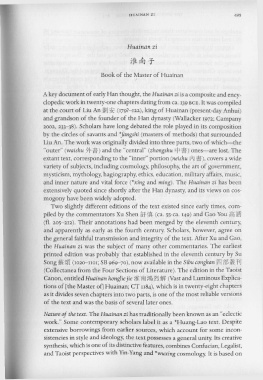Page 535 - The Encyclopedia of Taoism v1_A-L
P. 535
HUAINAN Z I 495
Huainan zi
Book of the Master of Huainan
I
A key document of early Han thought, the Huainan zi is a composite and ency-
clopedic work in twenty-one chapters dating from ca. 139 BeE . It was compiled
at the court of Liu An ;U!:fi:. (179?- 122), king of Huainan (present-day Anhui)
and grandson of the founder of the Han dynasty (Wallacker 1972; Campany
2002, 233- 38). Scholars have long debated the role played in its composition
by the circles of savants and *fangshi (masters of methods) that surrounded
Liu An. The work was originally divided into three parts, two of which- the
"outer" (waishu )'HI) and the "central" (zhongshu 9=J:i!n ones- are lost. The
extant text, corresponding to the "inner" portion (neishu 1*1 if), covers a wide
variety of subjects, including cosmology, philosophy, the art of government,
mysticism, mythology, hagiography, ethics, education, military affairs, music,
and inner nature and vital force (*xing and ming). The Huainan zi has been
extensively quoted since shortly after the Han dynasty, and its views on cos-
mogony have been widely adopted.
Two slightly different editions of the text existed since early times, com-
piled by the commentators XU Shen ~'~ (ca. 55-ca. 149) and Gao You ~~
(fl. 205-212). Their annotations had been merged by the eleventh century,
and apparently as early as the fourth century. Scholars, however, agree on
the general faithful transmission and integrity of the text. After XU and Gao,
the Huainan zi was the subject of many other commentaries. The earliest
printed edition was probably that established in the eleventh century by Su
Song 1Ii*~J't (I02Q-nOI; SB 969-70), now available in the Sibu congkan IZ!l $1tfiJ
(Collectanea from the Four Sections of Literature). The edition in the Taoist
Canon, entitled Huainan hongliejie ~ll¥J~?mfB1t- (Vast and Luminous Explica-
tions of [the Master of] Huainan; CT n84), which is in twenty-eight chapters
as it divides seven chapters into two parts, is one of the most reliable versions
of the text and was the basis of several later ones.
Nature of the text. The Huainan zi has traditionally been known as an "eclectic
work." Some contemporary scholars label it as a *Huang-Lao text. Despite
extensive borrowings from earlier sources, which account for some incon-
sistencies in style and ideology, the text possesses a general unity. Its creative
synthesis, which is one of its distinctive features, combines Confucian, Legalist,
and Taoist perspectives with Yin-Yang and *wuxing cosmology. It is based on

